Bordeaux wine tourism, part 2 – the right bank
No tourist in their right mind would start a tour of Bordeaux’s right bank anywhere other than the medieval town of St. Emilion, nestled into a limestone escarpment, just 35km north east of Bordeaux. The town and vineyard landscape, encompassing nearly 8,000 hectares (ha), including 5,400 ha of vines, have been a Unesco world heritage site since 1999. It was the first vineyard landscape to be so listed.
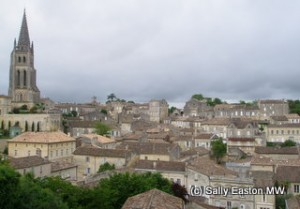
St. Emilion
A settlement was founded here by an 8th century monk, called Emilion, on the highest point of the limestone ridge, at around 100m above sea level. It’s a short, but gymnastically steep distance from the top at the Place du Clocher where the 15th century bell tower was built over the monolithic church, and the Place du Marché at the bottom of the slope.
Indeed the middle ages were the town’s heyday, after the golden age of pilgrimages in Europe had made the town a stopping place on the route to Santiago de Compostela, in the north western tip of Spain.
A long religious and political history surrounds the town and the vineyard culture, and a guided tour organised from the tourist office will furnish you with so much more than interesting stories of monks and nuns, the English rule during the 12th century when responsibility for the quality of the wine was given to twelve men, who also had jurisdiction over the town and it environs.
An hour and a half’s guided tour, available from the tourist office, will take in the hermit’s cave, the catacombs, Trinity chapel and the monolithic church. This latter is carved out of the limestone escarpment, with perfect proportions as though it had been constructed rather than excavated. It was once lavishly decorated and embellished, but time and dampness have taken their toll. Nonetheless two masses are held inside each year.
For anyone with a vinous bent, but not having made private appointments to visit wine properties, the tourist office also offers various wine tasting, visit and tour options.
If you want to stay in the vineyards rather than the town, Château Franc Mayne has nine rooms at its adjacent Le Relais de Franc Mayne. Each of the rooms is individually and uniquely designed: a blood-red and black Asian-theme; the muted browns and tans of the French country theme. I stayed in the richly decorated ‘British landscape’ room and felt like a welcome intruder into a plush country pile. The room looked out onto what they call a ‘natural swimming pool’ which the fluff said is ‘biologically purified using plants and micro-organisms”, with a regeneration zone and a filtration zone. It looked pretty, and relaxing, with vineyard views.
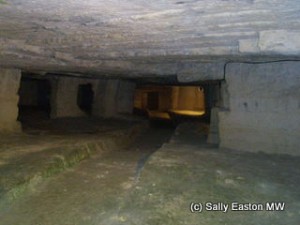
Franc Mayne limestone quarry
The Château has its own quarries on the property, dating from the 12th and 13th centuries, as do most of the quarries around St. Emilion, where barrels of the estate wine mature for 12 months. With a pretty constant 13°C and 80% relative humidity, these are decent natural conditions for wine maturation. And much like the monolithic church it looks as though the quarry walls have been constructed, with neat block lines, rather than deconstructed.
There’s an old post house (for the post/mail) on the Franc Mayne property which has just been renovated to become a new, dedicated tasting room, so the tour now takes you all the way through their quarry, emerging at the post house, ready to taste.
After which, a delightful 20 minute walk/30 minute stroll through the vineyards, coming out at the back of Beauséjour-Bécot, will take you the 1 kilometre into St. Emilion town, where the restaurant L’Envers du Décors is undoubtedly one of the best-known, and characterful watering holes, where the tables are topped with the branded ends of wines’ wooden boxes. Food was tasty, too.
A bit further out of St. Emilion, across the Dordogne and into the Entre-Deux-Mers, is one of the most family-friendly winery properties in Bordeaux. Château Cablanc lies in a protected nature reserve in the valley of the river Gamage, a tributary of the Dordogne. The reserve offers protection for such rare species as the European mink and four species of orchid. But dogs are still allowed, though not in the cellar.
Jean-Daniel Debart is the third generation to run the property. Since his grandfather bought the property 50 years ago, the vineyard has expanded to 60 ha, and the whole estate covers almost 120 ha of secluded farm and woodland.
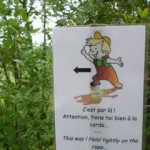
Cablanc activity trail
This surrounding restive woodland provides the terrain for Debart’s ‘secrets of the valley’ nature trail. It is a fun discovery trail for children and the child in all of us. Kids are given quiz and activity sheets appropriate to their age, and the family can spend a couple of hours on the trail, learning about woodland, the vineyard and wine. There are a series of shuttered boxes on the trail as part of the activities. At the top of the hill is a play and picnic area, and if you’ve forgotten to bring your own, picnics can be bought at the château.
Jean-Daniel, with three young boys of his own, has even managed to make the winery and cellar tour child-friendly and educational for all. It includes the use of toy machines to explain harvest, and listening to a recording of fermenting wine as a red strobe light flickers inside an empty vat. Adults get to taste the finished product in a tasting room that includes a table and chairs with colouring equipment and word games for younger ones.
For all of this, Château Cablanc has won the Great Wine Capitals of the world ‘Best of’ award for Sustainable Wine Tourism Practices.
Heading back across the river Dordogne, into the right bank, and 45 km north of Bordeaux city, is Blaye, where the citadel just last year (2008) became another in the clutch of Unesco world heritage sites for the Bordeaux region.
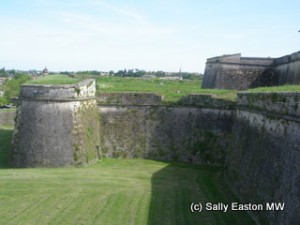
Blaye citadel fortifications
Blaye is not really a promontory, but more of a slight and strategic bulge into the Gironde estuary, and giving good enough reconnaissance for the Romans to have established a military base on the rocky protuberance.
The bulge narrows the estuary sufficiently for a more recent ferry service to be sited there, going to Lamarque (between Margaux and St. Julien communes), which avoids the long schlep into, through, and out again, of Bordeaux city to access the left bank.
The Roman base was replaced by a medieval fortress, and it was Vauban (Sébastien le Prestre, field marshall Vauban, b. 1633, d. 1707) who was the architect of the current imposing fortifications, one of 33 fortresses he created.
Blaye had evidently long been a key strategic defensive point for Bordeaux, and Vauban endeavoured to seal off the entire Gironde from marauding ships, by also constructing a fortress on the left bank – Fort Médoc – and on an island in between – Fort Paté. The Blaye citadel alone covers 33 hectares, or ¾ of a kilometre at its longest and nearly ½ kilometre at its widest.
The citadel is free to enter, there’s even a campsite at its heart, but it’s well worth booking a guided tour, both for the wealth of information as well as access to otherwise locked labyrinthine underground parts of the citadel. For the knowledge-hungry, the tourist office has a comprehensive document, all in English, detailing the history of Blaye’s citadel and Vauban’s influence.
The Romans didn’t just build a military base, they also brought vines, as to other parts of Bordeaux, and Blaye’s vineyards now extend over some 10,000 hectares. The region’s wines can be identified on the label by the appellation: Côtes de Bordeaux – Blaye.
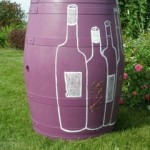
La Rose Bellevue
It is in this appellation that another touristic gem lies, right up in the top corner of the right bank, 20km north of Blaye, before the land heads off into Cognac territory. This is the poetically named Château La Rose Bellevue, where there is a pink and purple theme that’s close to my heart. Even the winery doors and several unused barrels are painted nearly-purple.
Winemaker Jérôme Eymas, fourth generation at the property, has a clutch of high profile work on his CV, including with Pfeiffer in Australia’s Rutherglen and Domaine Michel and Stéphane Ogier in Côte-Rôtie.
Aside from the refreshing wines, both of which whites – the Cuvee Tradition, and the barrel fermented Prestige – were really rather nice, it is for organising boat trips on the Gironde estuary that this enterprising property has more recently made its name, winning the Great Wine Capitals’ ‘Best of’ award for Innovative Wine Tourism Experiences in 2009.
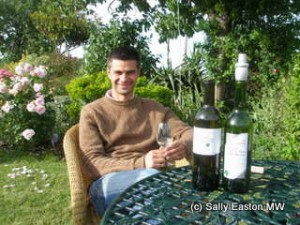
Jérôme Eymas in the secret garden
Leaving from Blaye port floating dock, the three hour tour includes wine tasting, a seafood lunch of oysters, langoustines, mussels, shrimps etc., and the ebullient Jérôme regaling you with his wines and quirky sense of humour.
If that’s enough to entice an exploration to the property itself, their ‘secret garden’, with a bring-your-own food barbecue, and pétanque, offers a more laid back way to enjoy a visit, and taste the wines. The ‘secret garden’ is more akin to ‘living alcoves’ of pink roses, evergreen bushes and a cherry tree planted by Jérôme’s grandfather. And if you’ve arrived sans picnic, you can buy one made up of local produce from the château. The secret garden creates a lovely image, the vineyard is right there, and Jérôme is a full-on friendly cellar guide.
Having had your fill of winery visits extra cases can be added at Planète Bordeaux. Or if you don’t have time to spend a luxurious day or two exploring the picturesque, rolling, mixed countryside of the right bank, you can pop the 30 minutes or so out of Bordeaux city and make a selection from the more than 1,000 producers of Bordeaux and Bordeaux Supérieur, that are stocked at this maison du vin. The wines are sold at the same price as at the Châteaux.
In addition to a well stocked cellar Planète Bordeaux offers visitors a listen, read and sniff exploration of wine and winemaking. There are loads of sniff and learn aromas: blackcurrant, oak, citrus, grapefruit, the whole spectrum of flavours in the glass. And there’s a series of educational spaces which take the visitor through grape growing, harvest and winemaking. It needs a bit of updating, but if you’re short of time or an enthusiastic oeno-neophyte, this could be a good starting point to get a feel for the basics.
This article was inspired by a visit to the region in May 2009 sponsored by the CIVB.



